Meet some of the longest-lived animals
That may be old for a human being. But for a glass sponge, turning 100 would be like a person reaching their first half-birthday. Compared to many animals, people do live

When you think a person is old, just how old are they? Does 50 seem old? What about 75? Or 100? That may be old for a human being. But for a glass sponge, turning 100 would be like a person reaching their first half-birthday. Compared to many animals, people do live a long time. But we’re hardly alone — and we’re nowhere near the longest-lived animals on the planet.
The oldest person on record was Jeanne Louise Calment of France. She lived for 122 years. She was born the year before Alexander Graham Bell patented the telephone and died in 1997 — one year after the first flip phone came out. That’s a long life! As of 2019, the average human life expectancy was 73.1 years.
People have generally been living longer than they did just a few decades ago, thanks to greater access to medicines, clean water and other life-saving resources. A 2021 study found that humans could probably even live up to 150 years. It’s unlikely people will ever live longer than that, the scientists say, because our bodies must work to repair themselves. And by the time we reach 100 years old, it’s difficult for our cells to keep up.
Other animals can live way longer. How long depends on a variety of things, from body size to habitat. Let’s see how some zoological old-timers’ lifespans measure up, what allows them to age so well — and how they are spurring fascinating new discoveries.
Naked mole rats — up to 40 years
A mere 8 centimeters (3 inches) long, these critters are about the size of mice. But mice live for about two years (if they’re lucky). A naked mole rat, on the other hand, can live to be 40.
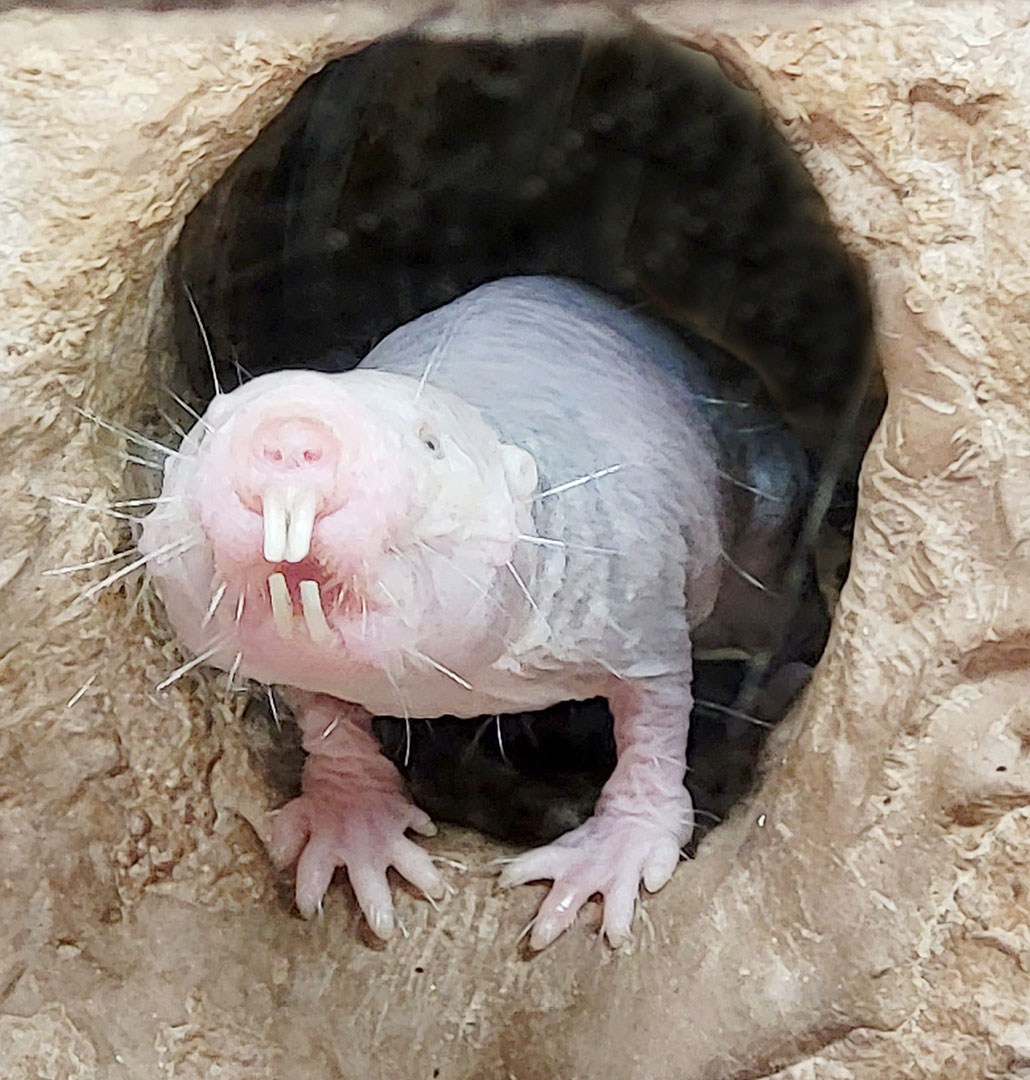
Naked mole rats rarely leave their underground burrows. This helps keep them safe from predators and other above-ground danger.Mark Newman/Lonely Planet RF/Getty Images
Being small often means having a short life, in part because other things want to eat you, says Juan Manuel Vazquez. He studies aging at the University of California, Berkeley. Since small animals are often prey for other animals, they have not evolved to have long lives.
What makes naked mole rats special? They live underground in large social groups, similar to what we see with honey bees and other social insects. Because they rarely pop their pink heads above ground, naked mole rats are hard for predators to nab. Without that pressure to grow up and reproduce quickly, they have evolved to live longer.
But living for decades means that naked mole rats must deal with other problems that shorter-lived creatures don’t. Diseases like cancer, for instance. A 2023 study found that these unusual rodents have high levels of anti-cancer compounds.
“They make a simple change to a common biomolecule” in their tissues, Vazquez says. The modified molecule starves cancer cells. And naked mole rats “become cancer-resistant as a result.”
Bats — more than 40 years
We know that bats can live to be at least 40, because the oldest known bat was caught 41 years after it was first tagged. It belonged to a species called Brandt’s bats, which are downright tiny. Each one weighs just 6 grams — about six large paper clips.
Not all bats live as long as Brandt’s bats. But even short-lived species survive 20 years — much longer than most similar-sized rodents. Bats seem to fly in the face of the small-animals-die-young trend. Why can they live so long?
Flying is one reason. Bats’ ability to take to the air when danger is near means they can avoid many predators. They find similar protection by roosting on the ceilings of caves or under bridges. Like naked mole rats, bats’ ability to avoid being eaten means they have not faced pressure to speed-run their lives. This has allowed them to evolve long lifespans.
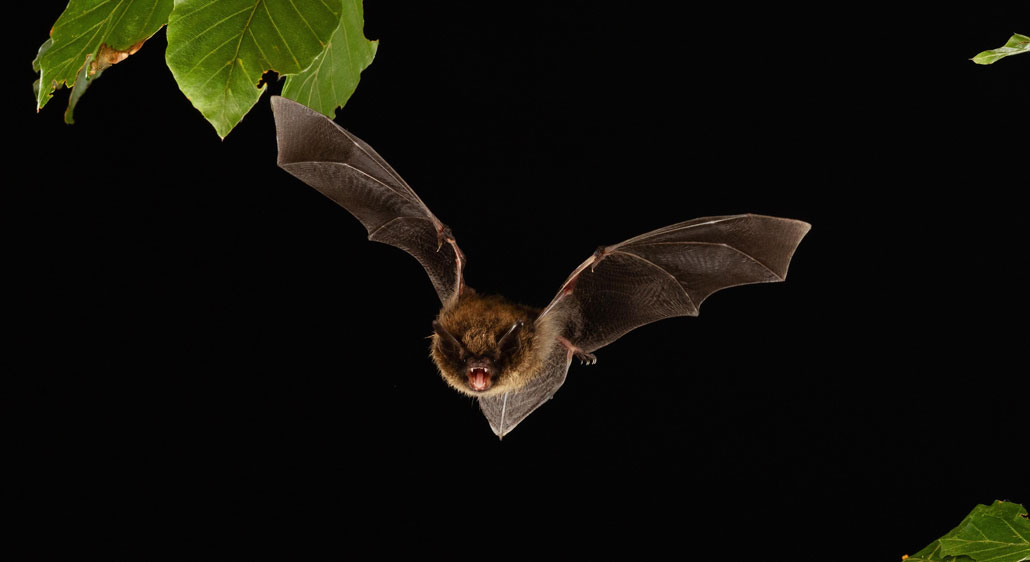
The oldest bat on record was a Brandt’s bat like this one. These tiny fliers can live to be at least 40 years old.imageBROKER/Franz Christoph Robiller/Getty Images
But bats have more than flying to thank for their long lives, Vazquez says. Come winter, most bats hibernate. Those that don’t still enter a shorter deep sleep called torpor.
In both hibernation and torpor, the body slows down. Bats “don’t really need to breathe” during hibernation, Vazquez says. Air passively enters their lungs. And their “wings are so thin that air just naturally diffuses through those membranes.” As a result, bats “just kind of go into a state of suspended animation.” This allows the animals to save energy, which seems to help them live longer.
In 2022, biologist Isabel Sullivan, then at the University of Maryland in College Park, led a study of big brown bats. Northern populations age more slowly during hibernation and live longer than southern populations that don’t hibernate, her team found.
Do you have a science question? We can help!
Submit your question here, and we might answer it an upcoming issue of Science News Explores
Kākāpōs – up to 100 years
The kākāpō (KAHK-ah-po) might be the bird with the longest lifespan, although people aren’t quite sure how long these parrots can live. Kākāpōs are found only in New Zealand. Conservation scientists there think the birds might reach the ripe old age of 90 — or even over 100.
Kākāpōs are flightless birds. But they don’t have any ground-dwelling predators on the islands of New Zealand. A lack of predators helps boost the lifespans of these birds, similar to the way it does for mole rats and bats. Kākāpōs had predators in the past: two birds of prey that went extinct about 600 years ago. Losing those predators might have extended their lifespan.
Kākāpōs may owe their long lives to a lack of predators and slow metabolisms.
What’s more, not flying allows the kākāpō to have “a relatively slow metabolism for a bird,” says Lara Urban. “That might contribute to it living longer.” Urban is a genomicist at Helmholtz Munich in Neuherberg, Germany. A genomicist studies an organism’s full set of DNA. A slow metabolism leads to less damage to DNA, which causes cells to age slower.
Kākāpō are unusual for other reasons, too. They have owl-like faces and exist in two color variations: bright green and olive. Both colors help them blend into their forest habitat. But scientists didn’t know why the two colors exist. Typically, if one color helps an animal survive or find mates, that color becomes the only one in the population.
A recent study led by Urban found that kākāpōs’ ancient predators, which hunted by sight, drove kākāpōs to develop two colors. Predatory birds would focus first on kākāpōs of one color. They’d find and eat those birds until they became less common, Urban explains. Then predators would focus on the other color. This switching kept both colors in the population, even long after the hunters were gone.
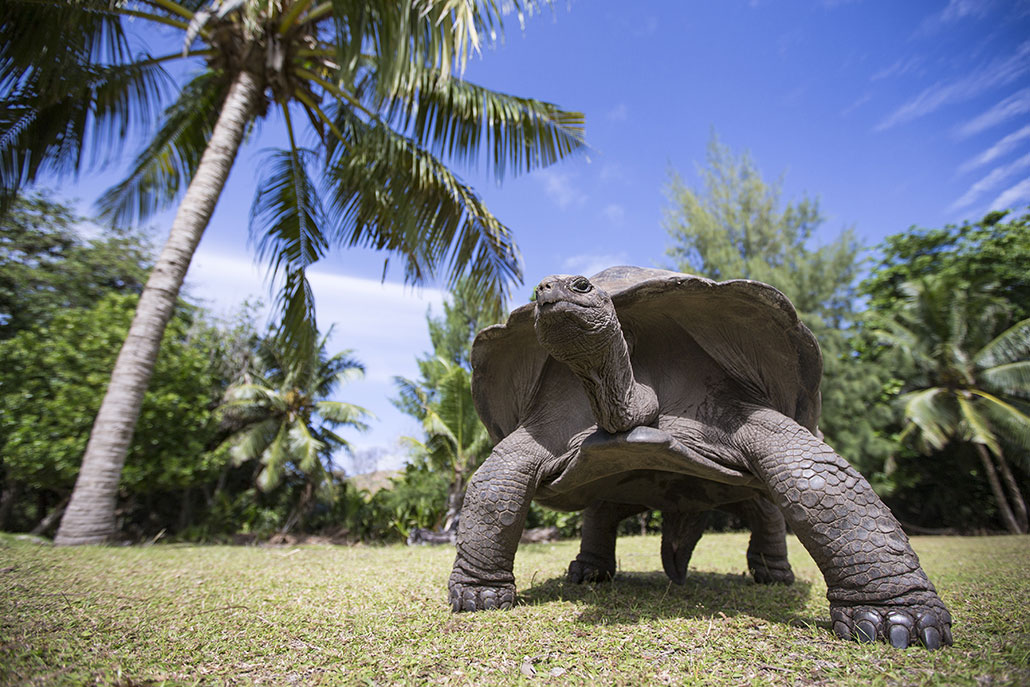
Giant tortoises play an important role in maintaining their forest habitats on tropical islands.Katiekk2/iStock/Getty Images Plus
Giant tortoises — up to 200 years
Most giant tortoises live well over 100 years, but one is nearing the 200 mark. Jonathan, a Seychelles giant tortoise, is at least 192 years old. He was given, fully grown, to the governor of St. Helena in 1882. (St. Helena is a remote tropical island in the south Atlantic.) Now, 31 governors later, Jonathan is still wandering the grounds of the governor’s plantation.
What helps tortoises live such long lives? For one thing, their metabolisms, like the animals themselves, run slow. And like many reptiles, giant tortoises are ectotherms. That means they don’t spend their own energy to keep their body warm, the way mammals do. Instead, they rely on external sources of warmth, like the sun.
Add in a strong, protective shell and large size, and there aren’t many predators that can eat tortoises. Those traits allow these animals to win the race against time — as long as people let them be.
The island nation of Madagascar, off the eastern coast of Africa, was once forested and home to many giant tortoises. But people hunted them. And they burned down forested areas, whose shade tortoises relied on to stay cool.
Helping that forest recover hasn’t been easy. But a 2024 study found giant tortoises can play a critical role by spreading tree seeds. By dropping seeds in pats of poop, the reptiles also make it more likely the seeds will begin to grow — helping restore their own ecosystems.

A bowhead whale surfaces to breathe in cold Arctic waters near Russia.wildestanimal/Moment/Getty Images
Bowhead whales — 200 years
Most of the longest-lived animals live in the ocean. There’s evidence that the biggest — great whales — may all be old-timers if they can avoid encounters with people. One in particular, the bowhead whale, holds the record for longest-lived mammal.
Bowheads live in icy Arctic waters. Cold temperatures tend to slow metabolism and extend lifespan. But these whales also have anti-cancer genes to keep them healthy.
Large animals like whales have more skin than small animals do. When they’re growing, they need to form new skin cells all the time. But once a whale is grown, it only needs new skin after a shark bite or other injury. So adult whales switch off genes in their DNA that promote skin growth. They switch on genes that help keep skin cells from growing out of control, which would cause cancer. “It’s like the emergency brake on the car,” Vazquez explains.
Bowhead whales seem to spend their long lives in good company. A 2024 study found that some bowheads appear to synchronize their diving even when they are more than 100 kilometers (60 miles) apart.
Evgeny Podolskiy, a marine geophysicist at Hokkaido University in Japan, led the study. “Whales might form a so-called ‘acoustic herd’,” he says. That is, “seemingly lonely animals are never alone.” Rather, they make up “a vast network of individuals interacting over vast ocean distances.”
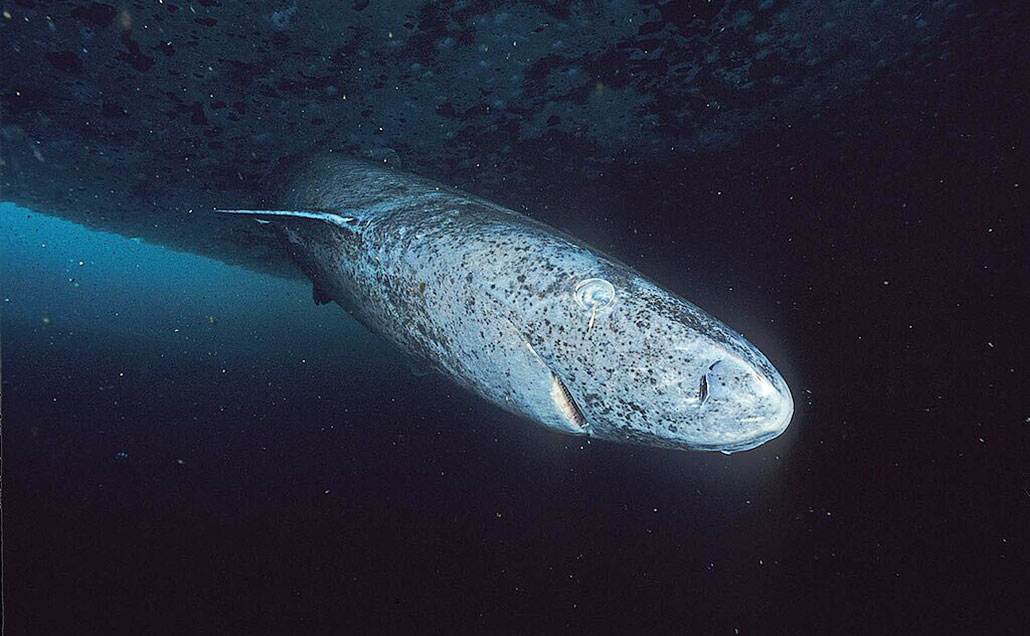
Scientists are just starting to uncover the secrets of deep-sea Greenland sharks.Hemming1952/Wikimedia Commons (CC BY-SA 4.0)
Greenland sharks — 400 years
Like bowheads, Greenland sharks live in cold north Atlantic and Arctic waters. Unlike whales, which spend most of their time near the surface, these sharks stay in the deep sea. They can live for centuries. We know this because scientists have used radiocarbon dating on these long-lived fish.
One reason for Greenland sharks’ long lives is their remote location. This keeps them away from ships, fishing gear and other potential dangers. Another reason is that they conserve energy, swimming at a leisurely 1 meter (3 feet) per second.
Greenland sharks grow very slowly, taking hundreds of years to reach their large adult size. Fully grown, they measure more than 5 meters (16 feet) long. But, like bowhead whales, they have lots of genes that keep them healthy.

Educators and Parents, Sign Up for The Cheat Sheet
Weekly updates to help you use Science News Explores in the learning environment
E-mail Address*Go
A recent study of Greenland shark DNA found dozens of genes that help repair DNA or prevent age-related disease, such as cancer. People have these genes, too, Vazquez points out. But Greenland sharks and bowhead whales have many more copies of them.
“Having more copies means you have a lot of spare tires in case something goes wrong,” he says. Long-lived animals have more time to gain harmful mutations in their DNA. All those extra copies of repair genes help keep such mutations from spreading.
Ocean quahog clams — 500 years
The oldest known ocean quahog (KOH-hog) reached 507 years old. Researchers collected it off the Icelandic ice shelf in 2006. We know its age because clams add annual rings to their shells, like trees add rings to their trunks.
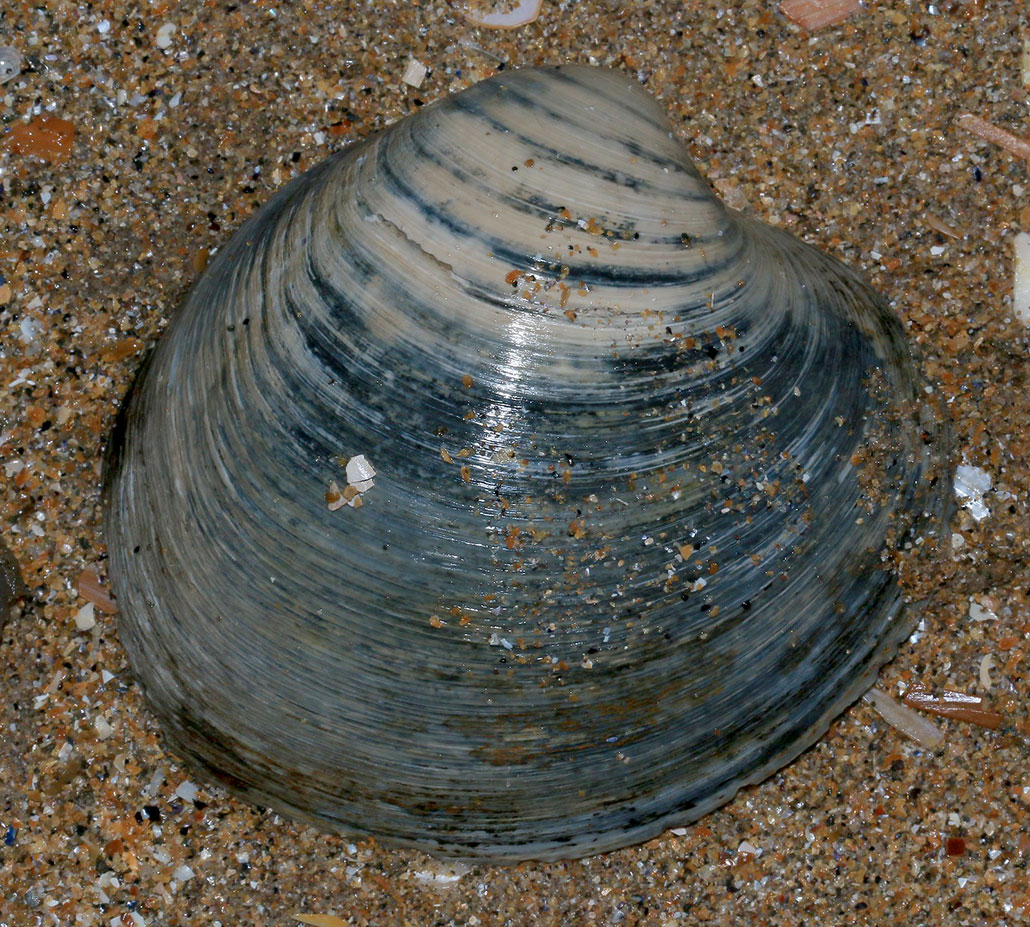
Ocean quahogs live in deeper waters than other kinds of quahog clams. Each ring on their shells reflects one year of growth.S. Rae/Flickr (CC BY 2.0)
Clams aren’t the most active animals, although their young larvae swim freely through the water until they find a good place to settle. Young clams are a popular food for lots of ocean animals. But once they grow big enough, clams can burrow into the ocean floor and close up their shells to stay safe.
These animals also burrow to keep cool. Ocean quahogs do best at 15° Celsius (60° Fahrenheit) or colder. And it seems that warm water poses a threat to their longevity.
Biologist Alyssa LeClaire works with the U.S. National Oceanic and Atmospheric Administration in Beaufort, N.C. She led a 2023 study of ocean quahog clams. In some parts of the ocean, young clams became much less common starting 120 years ago. This is probably due to warmer water from climate change. Older clams could protect themselves from too-warm water by burrowing deep into the seafloor. Young clams couldn’t escape hot water, so many of them died, leaving only the older clams in the population.
Black coral — 4,000 years
The oldest known black coral colony was more than 4,000 years old when collected.
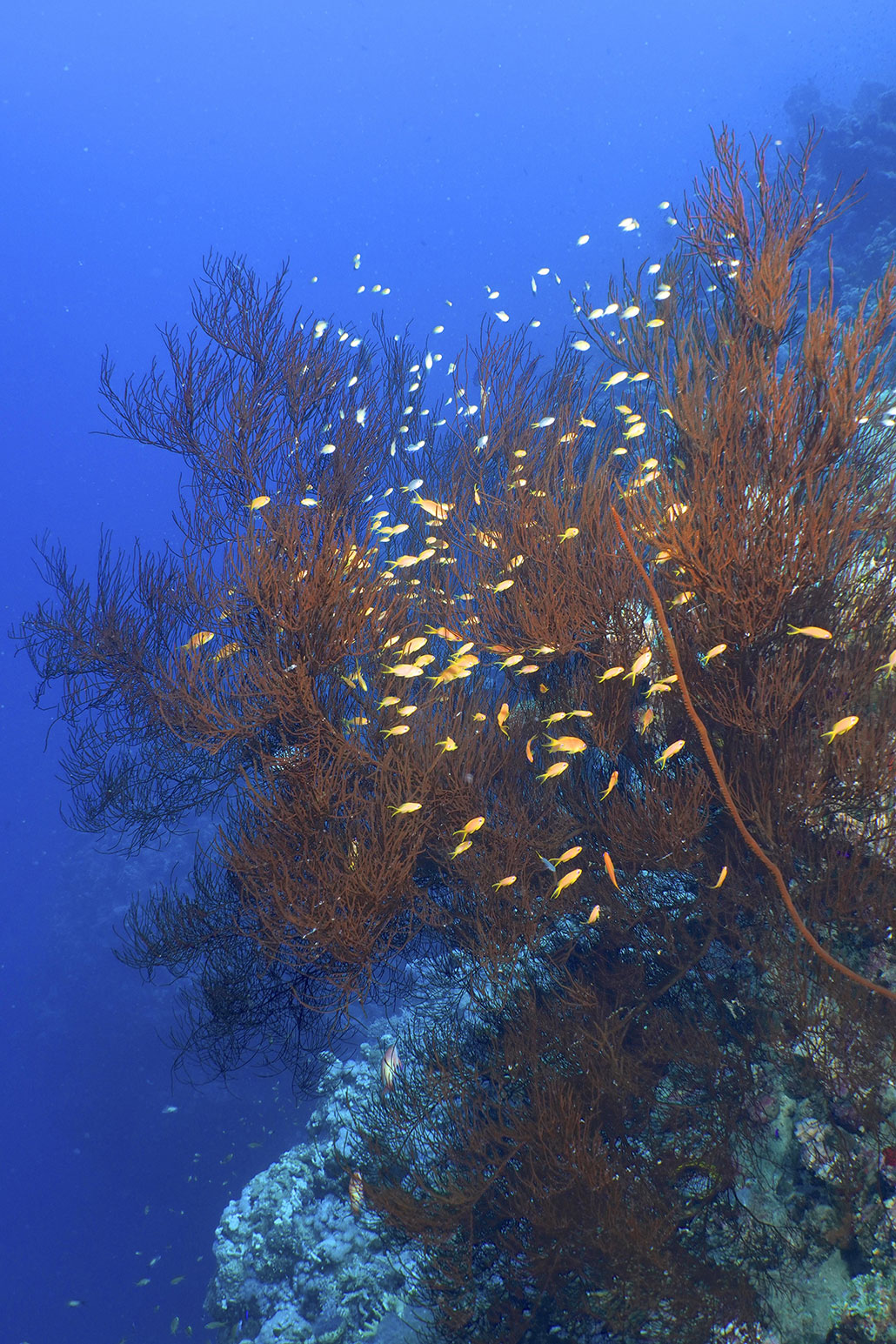
Only the skeleton of a black coral is black, so these animals appear in a variety of colors when they’re alive. All 150 species provide important habitats for other marine creatures.imageBROKER/Rolf von Riedmatten/Getty Images
Unlike hard, stony corals, black corals build their skeletons from chitin — the same stuff that makes up insects’ exoskeletons. Thousands of tiny animals called polyps build and share a coral colony’s tree-like skeleton. They add annual layers to the skeleton, much like tree rings. Dense forests of black corals create essential habitats for thousands of marine animals, including fish, squat lobsters and sharks.
Black corals live in all the world’s oceans. They can be found in shallow waters or up to 8.3 kilometers (5.2 miles) below the surface. Those that live in the coldest, deepest waters can live for millennia. Like Greenland sharks, this is likely due to the cold temps and remote location.
Despite this, black corals are threatened. They’re slow to grow and take a long time to reproduce. Their chitin skeleton polishes into beautiful pieces used in jewelry, so people often harvest them.
In 2024, a research group set out to study black coral reproduction. Understanding how they reproduce can help to protect dwindling populations. The team found that some black coral colonies are female and release only eggs. Some are male and release only sperm. When those cells meet, they can spawn new colonies. But some colonies change sexes from one breeding season to the next!
Glass sponge — 17,000 years
Without question, the oldest living animals on record are glass sponges. One deep-sea species, Monorhaphis chuni, was aged at 17,000 years. Scientists can figure out a sponge’s age by measuring how quickly these animals grow. They can then use that growth speed to calculate how long it must have taken living sponges to grow to their current size.
Like other long-lived marine animals, glass sponges live in cold waters, so they grow slowly. And “they live at great depths that are very stable environments,” says Andrzej Pisera. He is a paleobiologist who studies sponges at the Polish Academy of Sciences in Warsaw. Without the risk of predators or big waves, there aren’t many things around to kill glass sponges.
Sponges might not seem like animals, but they are — and they must eat to survive. To do so, they filter tiny pieces of food out of the water by creating a current. They move water through openings, which draws food inside the sponge.
The sponges spend their long lives anchored to the ocean floor with a single glass piece of its skeleton, or spicule. This anchoring, or basal, spicule is just 1 centimeter (0.4 inch) wide. But it can grow to be 3 meters (10 feet) long. That’s enormous for a spicule. Most are just a few millimeters long, Pisera says.
The basal spicule raises the sponge up off the seafloor, which helps it filter food from the water. In a 2021 study, Pisera found that these sponges arrange layers of silica in very specific ways to build a strong spike that holds them in place for thousands of years.
Can we all live longer?
“Aging is something that’s kind of fundamental to life itself,” Vazquez says. Organisms are born, grow up, grow old and eventually die. For people, age-related diseases like heart disease, diabetes and cancer play a big role.
But aging isn’t “an unsolvable, insurmountable problem,” Vazquez says. We have already overcome many diseases that used to shorten lifespan, he notes. Soon, diseases that are common in modern people might be cured too.
We aren’t anywhere near “curing” aging. And many people may not want to live to be 100 anyway. But almost everyone would like to have the health and energy of a 20-year-old while in their 80s. Scientists, including Vazquez, are working on making that a reality. They’re looking into the best diets for long-term health and developing new drugs for diseases. It’s “about making sure that we’re as healthy and fit as possible for the greatest proportion of our life,” he notes.
“I don’t believe aging is going to be cured in my lifespan,” he says. But he hopes that his kids or grandkids might live in a time when they don’t know what Alzheimer’s disease is. Or even some kinds of cancer. People may one day live longer, healthier lives — maybe even join the ranks of zoological old-timers.
Related Stories

How can Baby Yoda be 50 years old?
By Maria TemmingFebruary 27, 2023
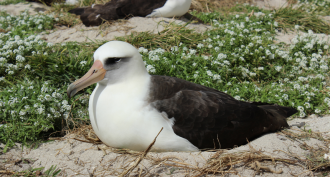
Oldest bird is new mom
By Allison BohacFebruary 26, 2013
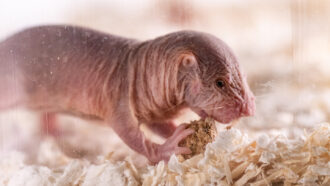
Unique dialects help naked mole-rats tell friends from foes
By Jonathan LambertFebruary 24, 2021
Power Words
Alzheimer’s disease: An incurable brain disease that can cause confusion, mood changes and problems with memory, language, behavior and problem solving. No cause or cure is known.
annual: Adjective for something that happens every year.
Arctic: A region that falls within the Arctic Circle. The edge of that circle is defined as the northernmost point at which the sun is visible on the northern winter solstice and the southernmost point at which the midnight sun can be seen on the northern summer solstice. The high Arctic is that most northerly third of this region. It’s a region dominated by snow cover much of the year.
Atlantic: One of the world’s five oceans, it is second in size only to the Pacific. It separates Europe and Africa to the east from North and South America to the west.
average: (in science) A term for the arithmetic mean, which is the sum of a group of numbers that is then divided by the size of the group.
basal: Of or relating to the base or bottom layer of something.
bat: A type of winged mammal comprising more than 1,400 separate species — or one in every four known species of mammal.
biologist: A scientist involved in the study of living things.
birds: Warm-blooded animals with wings that first showed up during the time of the dinosaurs. Birds are jacketed in feathers and produce young from the eggs they deposit in some sort of nest. Most birds fly, but throughout history there have been the occasional species that don’t.
birds of prey: Birds, such as falcons and owls, that hunt for their food.
cancer: Any of more than 100 different diseases, each characterized by the rapid, uncontrolled growth of abnormal cells. The development and growth of cancers, also known as malignancies, can lead to tumors, pain and death.
carbon dating: Short for radioactive-carbon dating or carbon-14 dating. A way to measure the age of organic materials — ones containing carbon. Carbon-14, a weakly radioactive isotope, forms in Earth’s upper atmosphere as cosmic rays hit nitrogen atoms. This carbon joins with oxygen to form carbon dioxide, which living organisms take up and incorporate in their tissues. When those organisms die, they stop exchanging carbon with the environment and the share of the carbon-14 isotope starts to fall at a constant rate (one set by the law of radioactive decay). By measuring the share of carbon-14 to carbon-12 in the organism’s remains, scientists can determine how long ago it died.
cell: (in biology) The smallest structural and functional unit of an organism. Typically too small to see with the unaided eye, it consists of a watery fluid surrounded by a membrane or wall. Depending on their size, animals are made of anywhere from thousands to trillions of cells. Most organisms, such as yeasts, molds, bacteria and some algae, are composed of only one cell.
chitin: A tough, semi-transparent substance that is the main component of the exoskeletons of arthropods (such as insects). A carbohydrate, chitin also is found in the cell walls of some fungi and algae.
climate: The weather conditions that typically exist in one area, in general, or over a long period.
climate change: Long-term, significant change in the climate of Earth. It can happen naturally or in response to human activities, including the burning of fossil fuels and clearing of forests.
conservation: The act of preserving or protecting something. The focus of this work can range from art objects to endangered species and other aspects of the natural environment.
conserve: To protect, as from loss or degradation.
coral: Marine animals that often produce a hard and stony exoskeleton and tend to live on reefs (the exoskeletons of dead ancestor corals).
current: A fluid — such as of water or air — that moves in a recognizable direction.
develop: To emerge or to make come into being, either naturally or through human intervention, such as by manufacturing. (in biology) To grow as an organism from conception through adulthood, often undergoing changes in chemistry, size, mental maturity or sometimes even shape.
diabetes: A disease where the body either makes too little of the hormone insulin (known as type 1 disease) or ignores the presence of too much insulin when it is present (known as type 2 diabetes).
diet: (n.) The foods and liquids ingested by an animal to provide the nutrition it needs to grow and maintain health. Sometimes this is a specific food-intake plan.
DNA: (short for deoxyribonucleic acid) A long, double-stranded and spiral-shaped molecule inside most living cells that carries genetic instructions. It is built on a backbone of phosphorus, oxygen, and carbon atoms. In all living things, from plants and animals to microbes, these instructions tell cells which molecules to make.
ecosystem: A group of interacting living organisms — including microorganisms, plants and animals — and their physical environment within a particular climate. Examples include tropical reefs, rainforests, alpine meadows and polar tundra. The term can also be applied to elements that make up some an artificial environment, such as a company, classroom or the internet.
ectotherm: The term for an animal that relies on outside sources of heat to control its body temperature. This means their body temperatures will change as temperatures in their environment changes. These creatures are commonly referred to as being cold-blooded.
egg: A reproductive cell that contains half of the genetic information necessary to form a complete organism. In humans and in many other animals, ovaries produce eggs. When an egg fuses with a sperm, they combine to produce a new cell, called a zygote. This is the first step in the development of a new organism."
evolve: (adj. evolving) To change gradually over generations, or a long period of time. In living organisms, such an evolution usually involves random changes to genes that will then be passed along to an individual’s offspring. These can lead to new traits, such as altered coloration, new susceptibility to disease or protection from it, or different shaped features (such as legs, antennae, toes or internal organs). Nonliving things may also be described as evolving if they change over time. For instance, the miniaturization of computers is sometimes described as these devices evolving to smaller, more complex devices.
exoskeleton: A hard, protective outer body covering of many animals that lack a true skeleton, such as an insect, crustacean or mollusk. The exoskeletons of insects and crustaceans are largely made of chitin.
extinct: An adjective that describes a species for which there are no living members.
filter: (n.) Something that allows some materials to pass through but not others, based on their size or some other feature. (v.) The process of screening some things out on the basis of traits such as size, density, electric charge.
focus: (in behavior) To look or concentrate intently on some particular point or thing.
forest: An area of land covered mostly with trees and other woody plants.
fundamental: Something that is basic or serves as the foundation for another thing or idea.
gene: (adj. genetic) A segment of DNA that codes, or holds instructions, for a cell’s production of a protein. Offspring inherit genes from their parents. Genes influence how an organism looks and behaves.
glass: A hard, brittle substance made from silica, a mineral found in sand. Glass usually is transparent and fairly inert (chemically nonreactive). Aquatic organisms called diatoms build their shells of it.
Greenland: The world’s largest island, Greenland sits between the Arctic Ocean and North Atlantic. Although it is technically part of North America (sitting just east of Northern Canada), Greenland has been linked more politically to Europe. Indeed, Vikings arrived in Greenland around the 10th century, and for a time the island was a colony of Denmark. In June 2009, Greenland became an independent nation. Ice covers roughly 80 percent of Greenland. Indeed, the Greenland ice sheet is the world’s largest. If its frozen water were to melt, it could raise sea levels around the world by 6 meters (about 20 feet). Although this is the 12th biggest nation (based on surface area), Greenland averages the fewest people per square kilometer of its surface area.
habitat: The area or natural environment in which an animal or plant normally lives, such as a desert, coral reef or freshwater lake. A habitat can be home to thousands of different species.
hibernation: A state of inactivity that some animals enter to save energy at certain times of year. Bears and bats, for example, may hibernate through the winter. During this time, the animal does not move very much, and the use of energy by its body slows down. This eliminates the need to feed for months at a time.
honey: A viscous (gooey) material that honeybees store in their honeycombs. The bees make it from nectar. Foraging bees visit flowers in search of that sugary liquid. Back at the hive, honeybees will add some enzymes to the nectar, then deposit the amber colored liquid into the hive’s combs. As worker bees use their wings to fan the cells containing this liquid, the goo heats up and some of its water will evaporate to form honey.
insect: A type of arthropod that as an adult will have six segmented legs and three body parts: a head, thorax and abdomen. There are hundreds of thousands of insects, which include bees, beetles, flies and moths.
larvae: Immature insects that have a distinctly different form (body shape) than when they are adults. For instance, caterpillars are larval butterflies and maggots are larval flies. (Sometimes this term also is used to describe such a stage in the development of fish, frogs and other animals.)
Madagascar: This island nation sits in the Indian Ocean, just east of the African nation of Mozambique. The world’s fourth largest island, Madagascar is home to many unique animals that have evolved in relative isolation. These include a number of primates, such as lemurs, chameleons of all sizes, birds and lots of butterflies.
mammal: An animal distinguished by possessing hair or fur, the secretion of milk by females for the feeding of their young, and (typically) the bearing of live young. They also are warm-blooded (or endothermic).
marine: Having to do with the ocean world or environment.
metabolism: (adj. metabolic) The set of life-sustaining chemical reactions that take place inside cells and bigger structures, such as organs. These reactions enable organisms to grow, reproduce, move and otherwise respond to their environments.
millennia: (singular: millennium) Thousands of years.
molecule: An electrically neutral group of atoms that represents the smallest possible amount of a chemical compound. Molecules can be made of single types of atoms or of different types. For example, the oxygen in the air is made of two oxygen atoms (O2), but water is made of two hydrogen atoms and one oxygen atom (H2O).
mutation: (v. mutate) Some change that occurs to a gene in an organism’s DNA. Some mutations occur naturally. Others can be triggered by outside factors, such as pollution, radiation, medicines or something in the diet. A gene with this change is referred to as a mutant.
National Oceanic and Atmospheric Administration: (or NOAA) A science agency of the U.S. Department of Commerce. Initially established in 1807 under another name (The Survey of the Coast), this agency focuses on understanding and preserving ocean resources, including fisheries, protecting marine mammals (from seals to whales), studying the seafloor and probing the upper atmosphere.
New Zealand: An island nation in the southwest Pacific Ocean, roughly 1,500 kilometers (some 900 miles) east of Australia. Its “mainland” — consisting of a North and South Island — is quite volcanically active. In addition, the country includes many far smaller offshore islands.
organism: Any living thing, from elephants and plants to bacteria and other types of single-celled life.
paleobiologist: A scientist who studies organisms that lived in ancient times — especially geologically ancient periods, such as the dinosaur era.
planet: A large celestial object that orbits a star but unlike a star does not generate any visible light.
plantation: A site where some species of tree or other valuable, wild-like plant (such as coffee, banana or tobacco) has been planted as a crop.
population: (in biology) A group of individuals (belonging to the same species) that lives in a given area.
predator: (adjective: predatory) A creature that preys on other animals for most or all of its food.
pressure: Force applied uniformly over a surface, measured as force per unit of area.
prey: (n.) Animal species eaten by others. (v.) To attack and eat another species.
proportion: The amount of a certain component of a mixture relative to other components. For example, if a bag contains 2 apples and 3 oranges, the proportion of apples to oranges in the bag is 2 to 3.
radiocarbon dating: Short for radioactive-carbon dating or simply carbon dating. A way to measure the age of organic materials — ones containing carbon. Carbon-14, a weakly radioactive isotope, forms in Earth’s upper atmosphere as cosmic rays hit nitrogen atoms. This carbon joins with oxygen to form carbon dioxide, which living organisms take up and incorporate in their tissues. When those organisms die, they stop exchanging carbon with the environment and the share of the carbon-14 isotope starts to fall at a constant rate (one set by the law of radioactive decay). By measuring the share of carbon-14 in the organism’s remains, scientists can determine how long ago it died.
reptile: Vertebrate animals belonging to a group known as Reptilia. Most reptiles have skin that is covered with scales or horny plates. Snakes, turtles, lizards and alligators are all reptiles. Once considered their own separate group, birds now belong to this order. With the exception of modern birds, most reptiles are cold-blooded (or ectothermic).
risk: The chance or mathematical likelihood that some bad thing might happen. For instance, exposure to radiation poses a risk of cancer. Or the hazard — or peril — itself. (For instance: Among cancer risks that the people faced were radiation and drinking water tainted with arsenic.)
rodent: A mammal of the order Rodentia, a group that includes mice, rats, squirrels, guinea pigs, hamsters and porcupines.
sea: An ocean (or region that is part of an ocean). Unlike lakes and streams, seawater — or ocean water — is salty.
sex: An animal’s biological status with respect to reproductive functions, typically male or female. There are a number of indicators of biological sex, including sex chromosomes, gonads, internal reproductive organs, and external genitals. It can also be a term for some system of mating between male and female animals such that each parent organism contributes genes to the potential offspring, usually through the fertilization of an egg cell by a sperm cell.
shark: A type of predatory fish that has survived in one form or another for hundreds of millions of years. Cartilage, not bone, gives its body structure. Like skates and rays, sharks belong to a group known as elasmobranchs. They tend to grow and mature slowly and have few young. Some lay eggs, others give birth to live young.
shell: The normally hard, protective outer covering of something. It could cover a mollusk or crustacean (such as a mussel or crab), a bird’s egg or some other relatively soft tissue that needs protection (such as a tree nut or peanut).
silica: A mineral, also known as silicon dioxide, containing silicon and oxygen atoms. It is a basic building block of much of the rocky material on Earth and of some construction materials, including glass.
social: (adj.) Relating to gatherings of people; a term for animals (or people) that prefer to exist in groups. (noun) A gathering of people, for instance those who belong to a club or other organization, for the purpose of enjoying each other’s company.
spawn: To quickly cause something to come into being. (in biology) To release or fertilize eggs in an aquatic environment.
species: A group of similar organisms capable of producing offspring that can survive and reproduce.
sperm: A reproductive cell that contains half of the genetic information necessary to form a complete organism. In humans and in many other animals, testes produce sperm. When a sperm fuses with an egg, the two combine to produce a new cell, called a zygote. This is the first step in the development of a new organism."
spicule: A small and usually slender, sharp-pointed crystal or part of some object.
sponge: (in biology) A primitive aquatic animal with a soft, porous body.
sun: The star at the center of Earth’s solar system. It is about 27,000 light-years from the center of the Milky Way galaxy. Also a term for any sunlike star.
suspended animation: A temporary shutdown of most or all living functions without causing death. Examples can include a stored seed, hibernating animal or permafrost-trapped rotifer.
threatened: (in conservation biology) A designation given to species that are at high risk of going extinct. These species are not as imperiled however, as those considered “endangered.”
torpor: A state of decreased activity in an animal. During torpor, an animal's body temperature falls and the activities of its cells slow.
tortoise: Any of various turtles that live on land.
trait: A characteristic feature of something. (in genetics) A quality or characteristic that can be inherited.
urban: Of or related to cities, especially densely populated ones or regions where lots of traffic and industrial activity occurs. The development or buildup of urban areas is a phenomenon known as urbanization.
wave: A disturbance or variation that travels through space and matter in a regular, oscillating fashion.
whale: A common, but fairly imprecise, term for a class of large mammals that lives in the ocean. This group includes dolphins and porpoises.